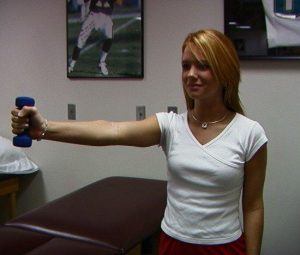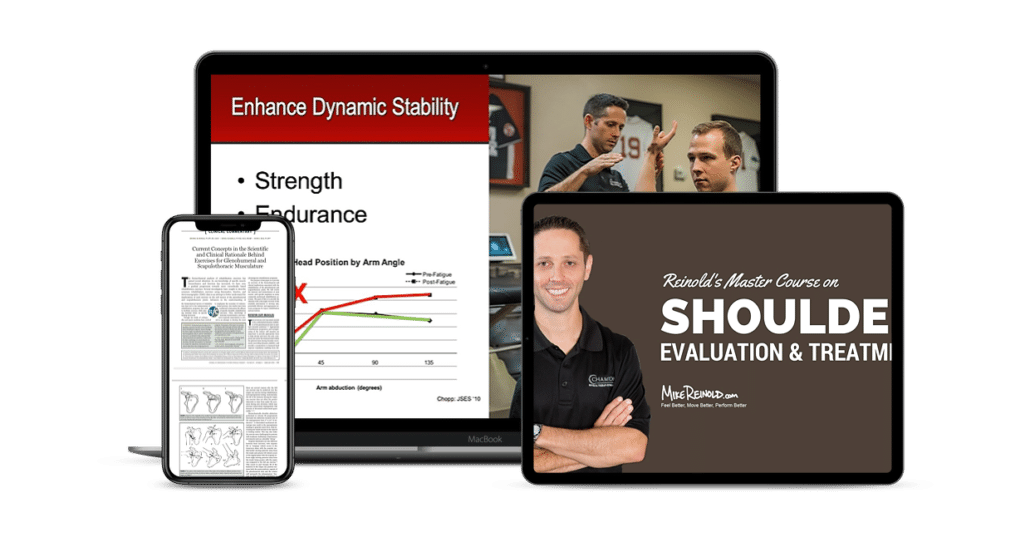Rotator cuff exercises are some of the most commonly performed exercises for both rehabilitation and corrective exercises. Considering the excessive mobility of the shoulder joint and crazy demands we place on the shoulder, it is no wonder that over 20% of the adult population has been shown to have some degree of rotator cuff tears! Furthermore, as we age and the stresses applied become cumulative, the prevalence of rotator cuff tears increases. That’s not even to mention all the people that may have shoulder impingement symptoms.
My past article on 3 Myths of Scapular Exercises was so popular, that I thought a similar article on myths of rotator cuff exercises was in order.
Below are some of my favorite myths of rotator cuff exercises, there are probably more than 4, but this is a start!
4 Myths of Rotator Cuff Exercises
Rotator Cuff Exercises Are Not Functional
A very popular trend right now is an emphasis on “functional” training, and rightfully so in my mind. However, I have heard many people imply that performing isolated rotator cuff exercises is not functional, and even worthless! Oh, how I couldn’t disagree more.
I have mentioned this recently in presentations, but our shift to “functional” training may be swaying too far in one direction, which tends to happen in a cyclical fashion. If you’ve been out in the real world for more than a decade, you know what I mean. We appear to be in a very “functional movement” cycle right now.
I think this is awesome. Our professions have made really exciting progress in our understanding of how the human body functions. By understanding and applying concepts of functional movement patterns, we truly can help people move better and perform better.
However, we can’t forget the basics. I often comment on some of the many studies that have been published on ACL rehabilitation that compare a traditional strength program with a program that emphasizes neuromuscular control. These studies always tend to show that BOTH groups do well and improve their functional status. But I always say, why choose one? If both work well in isolation, imagine what a combined approach would yield!
Saying that rotator cuff exercises are worthless is a bold statement. I understand that the cuff’s main role is to stabilize, I have taught this endlessly throughout my career. But, I can’t help but think that a weak muscle can’t stabilize. How are we going to efficiently perform a functional movement pattern if we have underlying weakness and muscle imbalances?
Stick with the rotator cuff exercises when weakness is present. Get strong, then get functional, otherwise you may just be creating disadvantageous compensatory patterns.
You Get Enough Rotator Cuff Work During Other Exercises
While it is certainly true that the rotator cuff fires during all upper body strengthening exercises, how the cuff functions during different activities is important to understand. The cuff is active during activities to maintain stability of the shoulder joint. This does involve activity of the cuff, but not at levels that will produce strength gains.
I have seen very strong and powerful weightlifters and athletes have terribly weak rotator cuffs. It always catches up to them.
If You Use Heavy Weights Your Cuff Shuts Off and Larger Muscles Take Over

Have you ever taken a step back and thought about that?
I think I know where this came from. Imagine you had a pretty weak rotator cuff during an exercises such as side lying external rotation. You can comfortably perform the exercise with 3 pounds. If I were to give you a 15 pound weight, I bet your form would be awful and you would just sling your arm back using your posterior deltoid and trapezius muscles. That is obviously not good, any time you overload a weak muscle you will get compensation. That applies to every muscle in the body.
But that doesn’t mean that you can’t slowly work your weight up to over 5 pounds as you get stronger. Why would you stop at 5 pounds? What if that isn’t challenging anymore? What is the point of that? Would you stop loading your squat at a certain weight and just sit there forever?
I routinely get patients into weight over 5 pounds when working the rotator cuff, some even in double digits. If you are compensating and using larger muscle groups, you may just not be strong enough for that weight.
Use the Same Weight During All Rotator Cuff Exercises
This one cracks me up and I am absolutely guilty of this myself! When we give someone a shoulder program to perform, why do we tell them to use the same weight for every exercise? Would you do this anywhere else in your body? Today we are going to squat, lunge, and deadlift with the same weight… Sounds funny, right?
Challenge each muscle during each exercise. If a weight is too light for one exercise, go up. Don’t get stuck in the habit of using the same weight for every exercise or you will almost certainly not be maximizing your gains for each muscle group. Remember, the goal is to get stronger.
So there are 4 myths of rotator cuff exercises that you should consider. What do you think about these myths? Do you think there are more? Like I said, there are probably more, but these at least came to my mind when I think about rotator cuff exercises.
Learn Exactly How I Evaluate and Treat the Shoulder
If you are interested in mastering your understanding of the shoulder, I have my acclaiming online program teaching you exactly how I evaluate and treat the shoulder!
The online program at takes you through an 8-week program with new content added every week. You can learn at your own pace in the comfort of your own home. You’ll learn exactly how I approach:
- The evaluation of the shoulder
- Selecting exercises for the shoulder
- Manual resistance and dynamic stabilization drills for the shoulder
- Nonoperative and postoperative rehabilitation
- Rotator cuff injuries
- Shoulder instability
- SLAP lesions
- The stiff shoulder
- Manual therapy for the shoulder
The program offers CEU for physical therapists and athletic trainers.







